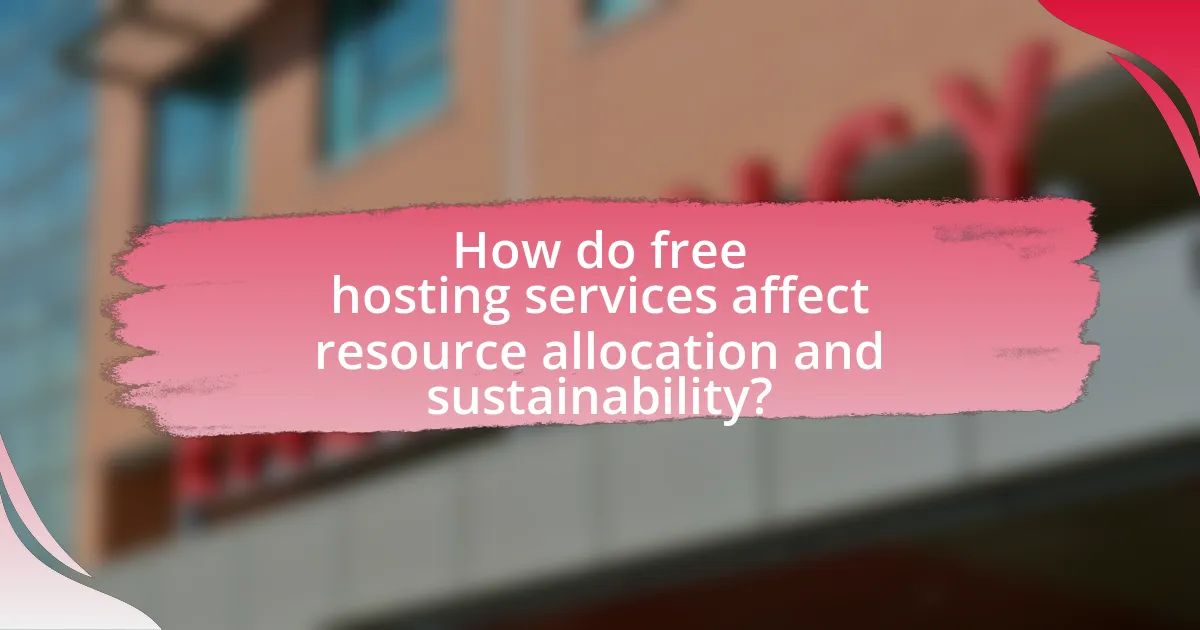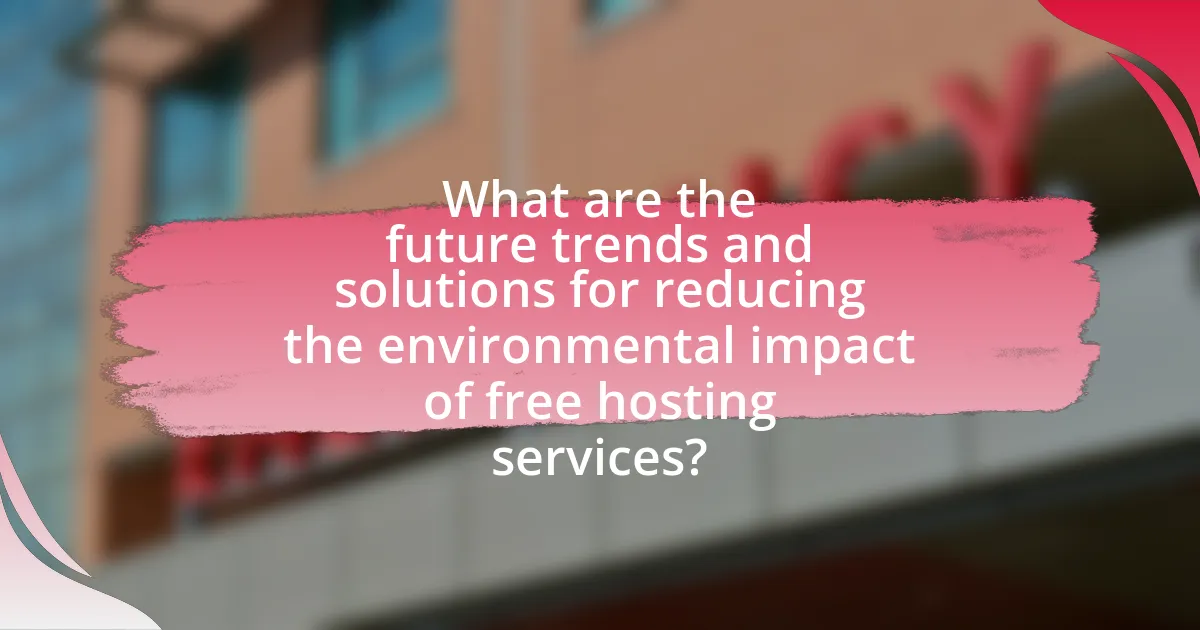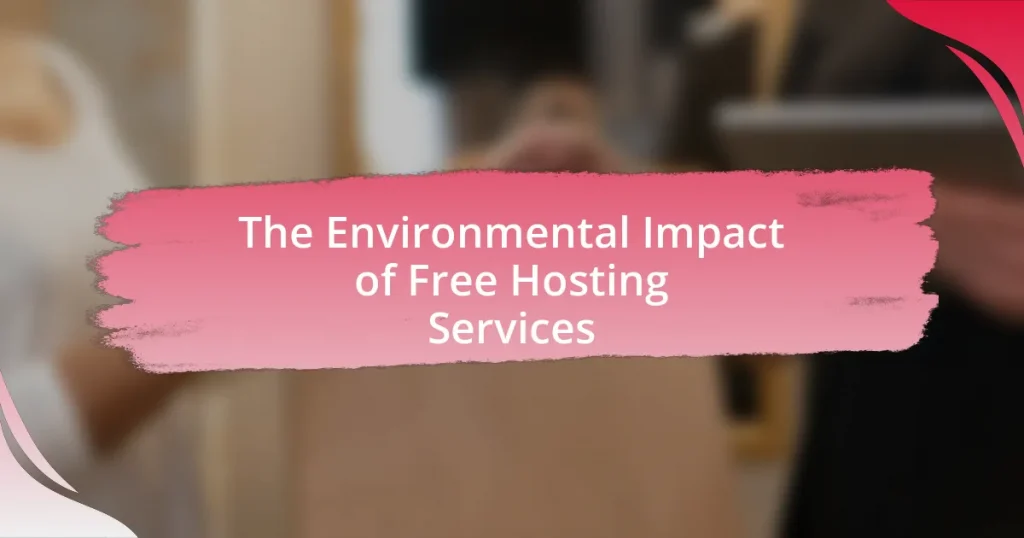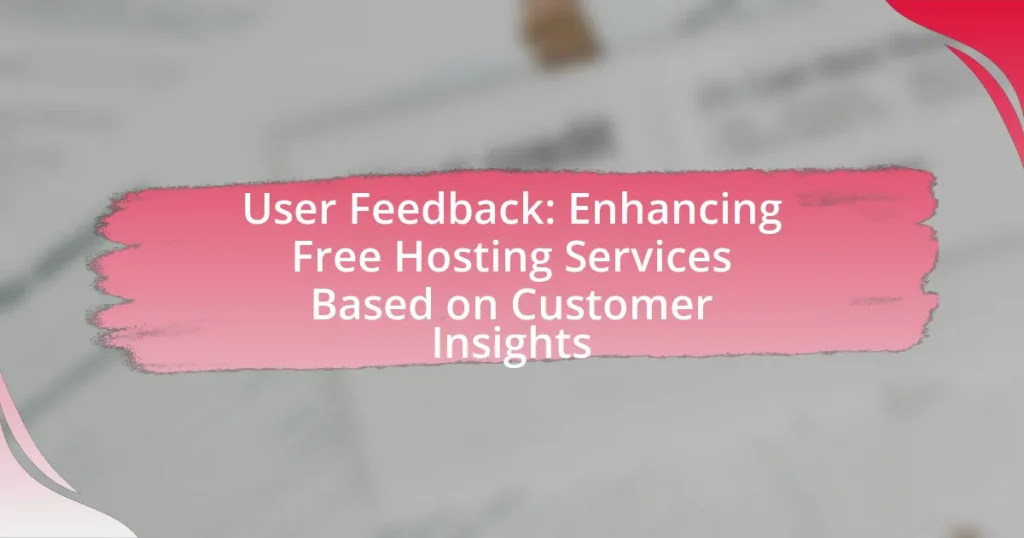The article examines the environmental impact of free hosting services, highlighting their reliance on energy-intensive data centers that often utilize non-renewable energy sources, contributing to greenhouse gas emissions. It discusses how these services operate, the resources they consume, and the implications of their infrastructure on sustainability. Key concerns include excessive energy consumption, electronic waste generation, and carbon emissions, with comparisons made to paid hosting options. The article also explores potential benefits of free hosting, strategies for improving sustainability, and user behaviors that influence environmental outcomes, ultimately emphasizing the need for eco-friendly practices in the hosting industry.

What is the Environmental Impact of Free Hosting Services?
Free hosting services have a significant environmental impact primarily due to their reliance on data centers that consume large amounts of energy. These data centers often operate on non-renewable energy sources, contributing to greenhouse gas emissions. For instance, a study by the International Energy Agency indicated that data centers accounted for about 1% of global electricity demand in 2020, with projections suggesting this could rise as digital services expand. Additionally, the cooling systems required to maintain optimal operating temperatures in these facilities further increase energy consumption. Therefore, while free hosting services provide accessible web solutions, they also contribute to environmental degradation through high energy usage and associated carbon footprints.
How do free hosting services operate and what resources do they consume?
Free hosting services operate by providing users with limited web hosting capabilities at no cost, typically funded through advertisements, upselling premium services, or data collection. These services consume resources such as server space, bandwidth, and energy, which are necessary for maintaining the infrastructure that supports user websites. For instance, a study by the International Energy Agency indicates that data centers, which host these services, accounted for about 1% of global electricity demand in 2020, highlighting the significant energy consumption associated with free hosting. Additionally, the reliance on shared resources can lead to increased server load and potential environmental impacts due to higher energy usage and carbon emissions.
What types of infrastructure are typically used by free hosting services?
Free hosting services typically utilize shared server infrastructure, which allows multiple users to host their websites on the same physical server. This approach minimizes costs by distributing resources among various users, leading to lower operational expenses for the hosting provider. Additionally, many free hosting services rely on cloud infrastructure, which offers scalability and flexibility, enabling them to manage varying levels of traffic without significant investment in physical hardware. This infrastructure model is supported by data indicating that shared and cloud hosting solutions account for a significant portion of the web hosting market, as they provide cost-effective options for users with limited budgets.
How does the energy consumption of free hosting services compare to paid options?
Free hosting services generally consume more energy per user compared to paid options. This is primarily due to the lower efficiency of free hosting providers, which often rely on shared resources and less optimized infrastructure. Research indicates that paid hosting services typically invest in better hardware and energy-efficient technologies, resulting in lower energy consumption per website. For instance, a study by the International Energy Agency highlights that data centers with optimized energy management systems can reduce energy use by up to 30% compared to less efficient setups commonly found in free hosting environments.
What are the primary environmental concerns associated with free hosting services?
The primary environmental concerns associated with free hosting services include excessive energy consumption, electronic waste generation, and carbon emissions. Free hosting services often rely on large data centers that operate continuously, consuming significant amounts of electricity, which contributes to higher greenhouse gas emissions. For instance, data centers accounted for about 1% of global electricity use in 2020, and this figure is projected to rise as demand for online services increases. Additionally, the rapid turnover of hardware in these services leads to increased electronic waste, which poses disposal challenges and environmental hazards.
How do free hosting services contribute to carbon emissions?
Free hosting services contribute to carbon emissions primarily through the energy consumption of their data centers. These data centers require significant electricity to operate servers, cooling systems, and other infrastructure, often relying on fossil fuels for power generation. According to the International Energy Agency, data centers accounted for about 1% of global electricity demand in 2020, and this figure is expected to rise as internet usage increases. The reliance on non-renewable energy sources in many regions exacerbates the carbon footprint associated with free hosting services, leading to higher greenhouse gas emissions.
What role does e-waste play in the environmental impact of free hosting services?
E-waste significantly contributes to the environmental impact of free hosting services by generating large amounts of electronic waste from outdated or discarded servers and data centers. The proliferation of free hosting services leads to increased demand for server infrastructure, which, when decommissioned, results in e-waste that often contains hazardous materials such as lead, mercury, and cadmium. According to the Global E-waste Monitor 2020, the world generated 53.6 million metric tons of e-waste in 2019, with only 17.4% being recycled properly. This improper disposal can lead to soil and water contamination, posing risks to human health and ecosystems. Thus, the role of e-waste in the environmental impact of free hosting services is critical, as it highlights the need for sustainable practices in managing electronic infrastructure.
What are the potential benefits of using free hosting services from an environmental perspective?
Using free hosting services can reduce environmental impact by minimizing resource consumption and energy use associated with server maintenance. These services often operate on shared infrastructure, which leads to more efficient use of hardware and lower carbon emissions per user. For instance, a study by the International Energy Agency indicates that shared hosting can decrease energy consumption by up to 80% compared to dedicated servers. Additionally, many free hosting providers are increasingly adopting renewable energy sources, further decreasing their carbon footprint. This shift not only conserves resources but also promotes sustainable practices within the tech industry.
Can free hosting services promote sustainable practices among users?
Free hosting services can promote sustainable practices among users by providing accessible platforms that encourage eco-friendly initiatives. These services often utilize shared resources, which can reduce energy consumption compared to individual hosting solutions. For instance, a study by the International Energy Agency indicates that shared hosting can lead to a 30% reduction in carbon emissions per user. Additionally, many free hosting providers are increasingly adopting green technologies, such as renewable energy sources, which further supports sustainable practices. By making eco-conscious hosting options available, these services can influence users to prioritize sustainability in their online activities.
How might free hosting services reduce the overall digital footprint of small businesses?
Free hosting services can reduce the overall digital footprint of small businesses by minimizing resource consumption and energy usage associated with web hosting. These services often utilize shared server environments, which optimize hardware utilization and decrease the need for additional physical servers. According to a study by the International Energy Agency, shared hosting can lead to a 70% reduction in energy consumption compared to dedicated servers. Additionally, many free hosting providers implement energy-efficient technologies and renewable energy sources, further lowering carbon emissions. By leveraging these services, small businesses can significantly decrease their environmental impact while maintaining an online presence.

How do free hosting services affect resource allocation and sustainability?
Free hosting services negatively impact resource allocation and sustainability by promoting overconsumption of digital resources. These services often rely on advertising revenue, leading to inefficient use of server capacity and increased energy consumption. For instance, a study by the International Energy Agency found that data centers, which host these services, accounted for about 1% of global electricity demand in 2020, with projections indicating a rise due to the proliferation of free hosting options. Consequently, the lack of financial accountability in free hosting models encourages users to create and maintain numerous websites, further straining environmental resources and contributing to carbon emissions.
What are the implications of resource allocation in free hosting services?
Resource allocation in free hosting services leads to significant implications for environmental sustainability. These services often rely on shared resources, which can result in inefficient energy use and increased carbon emissions due to underutilized servers. For instance, a study by the International Energy Agency indicates that data centers account for about 1% of global electricity demand, and inefficient resource allocation exacerbates this issue by maintaining idle servers that consume power without delivering value. Additionally, the competition for limited resources can lead to over-provisioning, where providers allocate more resources than necessary, further straining energy consumption and contributing to environmental degradation.
How does the demand for free hosting services impact natural resources?
The demand for free hosting services significantly impacts natural resources by increasing energy consumption and electronic waste. Data centers, which provide these services, require substantial electricity to operate and cool servers, contributing to higher carbon emissions and resource depletion. For instance, a report by the International Energy Agency indicated that data centers consumed about 1% of global electricity in 2018, a figure that is expected to rise as demand for online services grows. Additionally, the production and disposal of servers lead to electronic waste, which contains hazardous materials that can contaminate soil and water. This cycle of energy use and waste generation illustrates the environmental strain caused by the increasing reliance on free hosting services.
What strategies can be implemented to improve sustainability in free hosting services?
To improve sustainability in free hosting services, providers can implement strategies such as utilizing renewable energy sources, optimizing server efficiency, and promoting eco-friendly practices among users. Utilizing renewable energy, such as solar or wind power, significantly reduces carbon emissions associated with data centers. For instance, companies like Google and Microsoft have committed to powering their data centers with 100% renewable energy, showcasing a viable model for sustainability. Optimizing server efficiency through virtualization and load balancing minimizes energy consumption, as evidenced by studies indicating that efficient server management can reduce energy use by up to 30%. Additionally, encouraging users to adopt sustainable practices, such as minimizing resource-intensive applications and promoting digital minimalism, can further enhance the overall sustainability of free hosting services.
How do user behaviors influence the environmental impact of free hosting services?
User behaviors significantly influence the environmental impact of free hosting services by determining resource consumption patterns. When users frequently access and utilize these services, they increase server load, leading to higher energy consumption and greater carbon emissions. For instance, a study by the International Energy Agency indicates that data centers, which host these services, accounted for about 1% of global electricity demand in 2020, with user activity directly correlating to energy usage. Additionally, behaviors such as excessive data storage and high traffic volumes exacerbate the environmental footprint, as more servers are required to handle the increased demand. Thus, user engagement levels and usage patterns play a crucial role in shaping the overall environmental impact of free hosting services.
What practices can users adopt to minimize their environmental footprint when using free hosting services?
Users can minimize their environmental footprint when using free hosting services by selecting providers that prioritize renewable energy sources. Many hosting companies now operate data centers powered by wind or solar energy, which significantly reduces carbon emissions compared to those relying on fossil fuels. Additionally, users should optimize their website performance by minimizing resource usage, such as reducing image sizes and limiting unnecessary plugins, which can decrease server load and energy consumption. Furthermore, users can regularly audit their hosted content to remove outdated or unused files, thereby reducing storage needs and associated energy use. These practices collectively contribute to a lower environmental impact while utilizing free hosting services.
How does the choice of content and website design affect resource consumption?
The choice of content and website design significantly affects resource consumption by influencing the amount of data transferred and the processing power required for rendering web pages. Websites with heavy multimedia content, such as high-resolution images and videos, demand more bandwidth and energy for data transmission and server processing compared to text-based content. For instance, a study by the Shift Project found that streaming video accounts for over 60% of global internet traffic, which directly correlates to higher energy consumption in data centers. Additionally, complex website designs with numerous scripts and plugins can lead to increased CPU usage, further elevating energy demands. Therefore, optimizing content and simplifying design can reduce resource consumption and mitigate environmental impacts associated with web hosting.

What are the future trends and solutions for reducing the environmental impact of free hosting services?
Future trends and solutions for reducing the environmental impact of free hosting services include the adoption of renewable energy sources, improved energy efficiency in data centers, and the implementation of carbon offset programs. Renewable energy sources, such as solar and wind, are increasingly being utilized by hosting providers to power their operations, significantly lowering carbon footprints. For instance, companies like Google and Microsoft have committed to operating their data centers on 100% renewable energy. Additionally, advancements in energy-efficient technologies, such as liquid cooling and server virtualization, help reduce energy consumption. Carbon offset programs, which allow companies to invest in environmental projects to compensate for their emissions, are also gaining traction among hosting services. These strategies collectively contribute to a more sustainable approach to free hosting services, addressing their environmental impact effectively.
What innovations are emerging to make free hosting services more sustainable?
Emerging innovations to make free hosting services more sustainable include the adoption of renewable energy sources, energy-efficient data centers, and advanced cooling technologies. For instance, many hosting providers are transitioning to solar and wind energy to power their operations, significantly reducing their carbon footprint. Additionally, the implementation of energy-efficient hardware and virtualization technologies allows for better resource utilization, minimizing energy consumption. According to a report by the International Energy Agency, data centers can reduce energy use by up to 80% through these advancements. Furthermore, innovative cooling solutions, such as liquid cooling and free-air cooling, are being utilized to decrease the energy required for temperature regulation in data centers. These innovations collectively contribute to a more sustainable approach in the free hosting sector.
How can renewable energy sources be integrated into free hosting services?
Renewable energy sources can be integrated into free hosting services by utilizing solar, wind, and hydroelectric power to supply the energy needs of data centers. For instance, companies can install solar panels on the rooftops of their facilities or invest in wind farms to generate electricity, thereby reducing reliance on fossil fuels. According to a report by the International Renewable Energy Agency, transitioning to renewable energy can significantly lower carbon emissions, with solar energy alone capable of providing up to 90% of a data center’s energy needs in optimal conditions. Additionally, partnerships with renewable energy providers can facilitate the procurement of green energy credits, ensuring that the energy consumed is sourced from renewable facilities. This integration not only mitigates the environmental impact of free hosting services but also aligns with global sustainability goals.
What role do regulations and policies play in shaping the sustainability of free hosting services?
Regulations and policies significantly influence the sustainability of free hosting services by establishing standards for environmental practices and resource management. These regulations often mandate energy efficiency, waste reduction, and carbon footprint minimization, compelling hosting providers to adopt greener technologies and practices. For instance, the European Union’s General Data Protection Regulation (GDPR) and the EU’s Green Deal push companies to enhance their environmental accountability, which directly impacts how free hosting services operate. Compliance with such regulations can lead to the adoption of renewable energy sources and improved data center efficiency, thereby promoting sustainability in the sector.
What practical steps can users take to choose environmentally friendly free hosting services?
Users can choose environmentally friendly free hosting services by researching providers that utilize renewable energy sources for their data centers. Many hosting companies, such as GreenGeeks and A2 Hosting, commit to sustainability by powering their operations with wind or solar energy, which significantly reduces carbon footprints. Additionally, users should look for services that have clear sustainability policies and certifications, such as Energy Star or Green Certification, which indicate a commitment to environmentally responsible practices. Checking for transparency in energy usage and carbon offset initiatives can further guide users in selecting eco-friendly options.
How can users evaluate the sustainability practices of free hosting providers?
Users can evaluate the sustainability practices of free hosting providers by examining their energy sources, data center efficiency, and commitment to carbon neutrality. Specifically, users should look for providers that utilize renewable energy sources, such as solar or wind power, as this significantly reduces their carbon footprint. Additionally, assessing the energy efficiency of data centers, which can be measured by metrics like Power Usage Effectiveness (PUE), provides insight into how effectively a provider manages energy consumption. Furthermore, users should investigate whether the hosting provider has publicly committed to sustainability goals, such as achieving carbon neutrality by a specific year, which indicates a proactive approach to environmental responsibility.
What are the best practices for minimizing environmental impact while using free hosting services?
To minimize environmental impact while using free hosting services, users should prioritize providers that utilize renewable energy sources for their data centers. Research indicates that data centers consume about 1-2% of global electricity, and transitioning to renewable energy can significantly reduce carbon emissions associated with hosting. Additionally, optimizing website performance through efficient coding and minimizing resource usage can lower energy consumption. Implementing caching strategies and using content delivery networks (CDNs) can also reduce the load on servers, further decreasing energy demand. Lastly, regularly reviewing and deleting unused accounts or files can help reduce the overall storage footprint, contributing to lower environmental impact.















